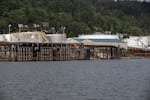
A six-mile stretch of Northwest Portland is known as the Critical Energy Infrastructure Hub, where hundreds of tanks store more than 300 million gallons of fuel on soil that would become unstable during a major earthquake.
Courtesy of Multnomah County
A Cascadia Subduction Zone earthquake could potentially cause the biggest fuel spill in U.S. history right in the middle of Portland, according to a new report.
A magnitude 8 or 9 earthquake would cause deadly explosions and fires, the study says, and it would cost billions of dollars in repairs with devastating ecological impacts on the Willamette and Columbia rivers.
The Multnomah County Office of Sustainability and the Portland Bureau of Emergency Management commissioned the study released on Monday that evaluates the potential damage a mega-earthquake could cause along a six-mile stretch of Portland’s industrial Northwest known as the Critical Energy Infrastructure Hub.
The area is home to more than 600 storage tanks full of fuels like oil, gasoline and diesel. More than 90% of the state’s liquid fuel supply is transported through the facilities located on this stretch of land, where scientists say the soil would liquefy during an earthquake and likely dump millions of gallons of stored fuel into the river.
“The spill would happen in a matter of minutes, in the immediate wake of a disastrous earthquake in the heart of a major American city,” Multnomah County Chair Deborah Kafoury said during a press conference on the report.

The Critical Energy Infrastructure Hub is a six-mile area on Portland's Willamette River that transports and stores 90% of the state's fuel supply.
Courtesy of Multnomah County
The report by the consulting firm ECONorthwest forecasts that a mega-earthquake could result in 397 tanks releasing up to 194 million gallons of fuel stored in the industrial area, potentially exceeding the 134 million gallons released into the Gulf of Mexico after the Deepwater Horizon oil spill in 2010.
“We just marked the 322nd anniversary since the last big one, which means that the next earthquake isn’t a matter of if. It’s strictly a matter of when,” Kafoury said.
She said the report is the clearest picture to date of what damages the region could see after an earthquake of that magnitude. When the big one hits, Kafoury said the soil will loosen and shake like a “Jell-O mold” that would then send all of the fuel infrastructure in “the CEI hub” into the Willamette River.
“Essentially the amount of oil spilled into the Willamette River and the areas surrounding the CEI Hub after a Cascadia earthquake would rival that of the [BP] Deepwater Horizon,” she said.
About 57% of released fuels would go into the ground and 43% would flow downstream into the Willamette River with the potential to cause environmental damage all the way to the mouth of the Columbia River.
The fuel would also cause explosions that would create immediate and long-term health effects for people in the surrounding communities breathing hazardous toxins. It would also cause widespread economic loss, including a disruption to the supply chain that distributes these fuels throughout the state.
The report estimates this type of earthquake would cause a minimum of $2.6 billion in damage, with clean-up being the highest cost. ECONorthwest’s Project Manager Laura Marshall said finding an estimate was a challenge, as there have been no prior events to look at for similarities.
“The total cost in damages would likely be many multiple times of that monetized amount based on what we’ve seen in other locations,” she said.
The Critical Energy Infrastructure hub was built before there was an understanding of the region’s earthquake risk, Marshall said, and there was a lack of information for 193 storage tanks in the area.
“We know these things are pretty old, the average tank age for the data that we do have is 1954, which is well before any of the seismic standards we have today,” she said.
During the press conference, Sen. Michael Dembrow, D-Portland, said the government needs to take action to protect the community from these devastating impacts.
“Government needs to step up to make sure that these fuel tanks are in position to withstand the worst effects of this shaking and liquefaction to protect life and environment,” he said. “Right now, the necessary oversight is fragmented or outright lacking.”
Earlier this month, Dembrow introduced Senate Bill 1567 which will create a program within the Oregon Department of Environmental Quality to regulate fuel tanks and require that energy terminal owners provide vulnerability assessments starting in the summer of 2024.
The bill would also require the Oregon Department of Energy to develop an energy security plan to be better prepared for this type of disruption from seismic events to protect local communities.
